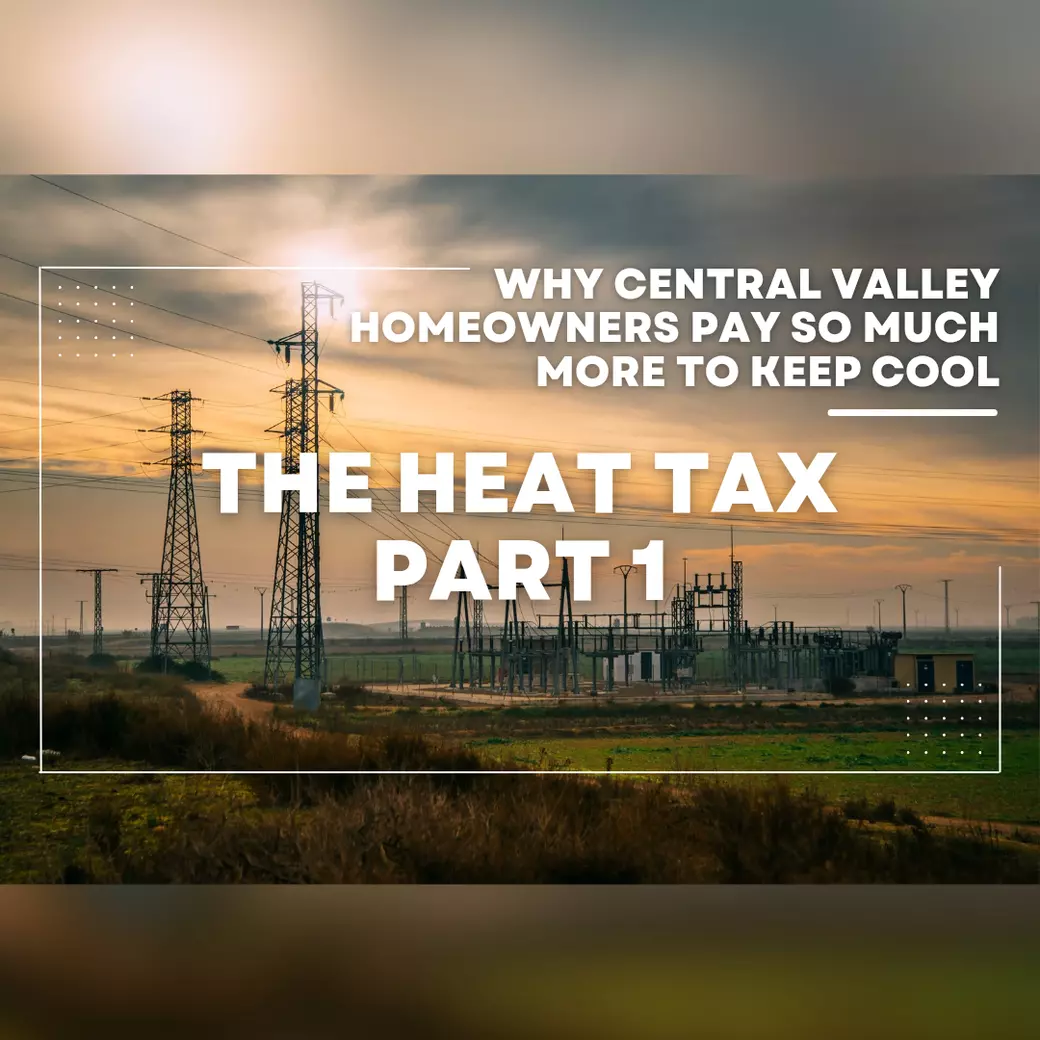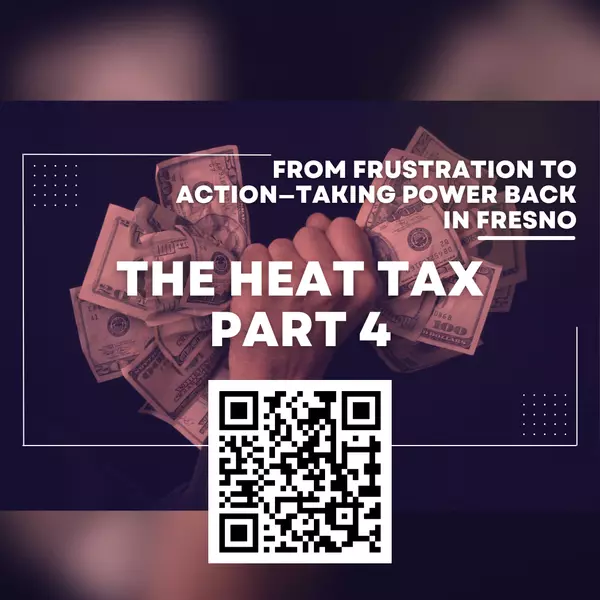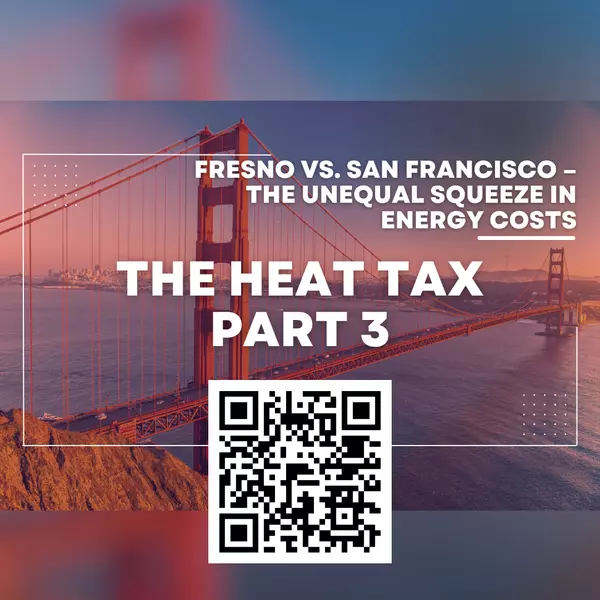The Heat Tax – Why Central Valley Homeowners Pay So Much More to Keep Cool

Part 1
Fresno’s summer sun looks inviting, but the region’s residents have been paying a steep “heat tax” in their PG&E bills. Central Valley homeowners (Fresno/Clovis) now face some of the highest utility bills in California – higher per household than booming cities like Sacramento or San Diego. According to a recent study, Fresno families spend an average of $3,123 per year on electricity – the highest in the nation – even as PG&E records enormous profits and regulators approve repeated rate hikes. Critics say those hikes have padded shareholder returns instead of shielding working families. Meanwhile, our abundant sunshine isn’t translating into savings: under new rules, solar panels earn far less from the grid than before, slowing payback and enrollment.
Key points to know:
Highest bills: Fresno households pay an average of ~$3,123/yr on electricity, topping any other U.S. city.
Record profits: PG&E posted a $2.47 billion profit in 2024, even as the CPUC approved six rate increases last year.
Solar savings cut: California’s NEM 3.0 policy (effective April 2023) slashes export credits by ~75%, drastically reducing rooftop solar returns.
Reform efforts: State lawmakers have introduced bills to cap rate hikes and strengthen utility oversight in response to the squeeze on consumers.
Why Are Fresno’s Rates So High?
Several factors drive our soaring bills. A state report (CPUC SB 695) notes that wildfire safety upgrades and the costs of the Net Energy Metering (NEM) program have been “the largest contributors” to recent rate hikes. PG&E itself acknowledges that average rates have roughly doubled (+101%) over the last decade. In practical terms, this means the same kilowatt of power costs far more today than it did years ago – even before any additional usage. On top of that, PG&E is seeking to lock in big dividends for investors: in early 2025 the utility asked regulators for an 11.3% return on equity, which would add roughly $5.50 per month to a typical household bill. In short, infrastructure and fuel costs (many stemming from fire-prevention work and aging equipment) have steadily risen, and corporate financing requests are adding to the pressure on customer bills.
Cut Solar Credits: NEM 3.0 (Solar Billing Plan)
California’s new NEM 3.0 program (called the Solar Billing Plan) has dramatically reduced incentives for rooftop solar. Under NEM 3.0, excess solar energy exported to the grid is no longer credited at the full retail rate. Instead, homeowners receive a wholesale “avoided-cost” export credit that can be as low as a few cents per kWh. In practice this is roughly a 75% cut compared to the old net-metering value. Industry analysts note that this change greatly extends solar payback times: a typical 7.6 kW solar system that used to pay off in ~4.6 years now takes around 6.5 years under NEM 3.0. The shift effectively forces new solar owners to add batteries (for extra export credit) if they want to recover costs in a reasonable timeframe. Meanwhile, homes already on older NEM 1.0/2.0 agreements keep their richer terms for up to 20 years, creating a two-tier system.
Export credits cut ~75%: The CPUC set export rates as low as $0.02–$0.04/kWh in summer – only about 25–30% of retail – a drastic reduction in value.
Battery bonus: Solar+storage systems get roughly +1.5¢/kWh extra credit, but solar-only homes lose the most under NEM 3.0.
Longer payback: Without battery add-ons, a typical solar array’s payback jumps from ~4.6 years under NEM 2.0 to ~6.5 years under NEM 3.0.
Not retroactive: Existing solar customers remain on their original net-metering plans for 20 years; only new installations (post-Apr 2023) fall under the reduced-credit regime.
Impact on Homeowners
High utility bills directly affect home budgets. EnergySage reports that Fresno homes now spend about $373 per month on electricity – roughly $4,476 per year – which is about 78% above the U.S. average. Adding gas service pushes a dual PG&E bill to ~$295/month (≈$3,540/yr) on average. These utilities expenses add up: over a decade they amount to tens of thousands of dollars per household, effectively inflating the true cost of owning a home here. Buyers who chose Fresno’s relatively lower home prices must also account for these higher carrying costs. In hot Central Valley summers the mandatory air conditioning can produce bill shock – an invisible “tax” that makes Fresno housing less affordable in practice.
“Our people just want hope,” says Fresno Mayor Jerry Dyer. “They can’t continue to see increases in their PG&E bill every year.” That frustration is shared by realtors, economists and local officials, who point out that an ostensibly cheaper Fresno home can quickly become much more expensive to operate than a home in a lower-cost energy market.
Lawmakers, Regulators, and Reform
This crisis has drawn political attention. Critics fault the California Public Utilities Commission for a lack of consumer protection. Consumer groups note that PG&E’s eye-popping profits mean ratepayers are footing the bill: “PG&E’s record profits come straight from ratepayers’ pockets,” warned the Environmental Working Group. State lawmakers have begun pushing back. In 2025 bills have been introduced to cap any utility rate hike to the rate of inflation and to limit utilities to one increase per year. One proposal (the “IOU Accountability Act”) would also impose stricter audits of infrastructure spending and executive pay. At the same time, legislators like Sen. Melissa Hurtado and Asm. Joaquin Arambula have publicly pressed regulators to “focus on people” and explore all options (from more hydroelectricity to small nuclear) to drive down costs. These efforts reflect mounting pressure, but tangible relief is still pending.
Locally, the tension plays out in public forums. In 2024 Fresno’s mayor even blasted PG&E at the State of the City for gouging local residents, and PG&E has tried to repair relations (for example, by donating $500,000 toward local sustainability programs). But until policy changes happen, everyday homeowners may have to organize and advocate for better energy policies themselves.
What’s next: This post is Part 1 of our series on the Central Valley heat tax. In Part 2 we’ll compare Fresno’s situation to other Sun Belt regions (like Phoenix) – examining how energy rates and housing costs stack up. Part 3 will take a deeper dive into PG&E’s finances and the CPUC’s role, and how Californians can push for accountability. Finally, Part 4 will outline a vision for energy reform and concrete steps that residents of the Central Valley can take now to fight back against rising utility costs.
Sources:
Pacific Gas & Electric Company documents; California Public Utilities Commission and Public Advocates reports; local news (GV Wire, KCRA, Fresno Business Journal) and industry analyses (EnergySage, EWG, etc.):
Pacific Gas & Electric Company – Solar Billing Plan FAQs (2023).
EnergySage – Electricity Cost in Fresno, CA (2025 data).
Environmental Working Group – Press release on PG&E profits (Feb. 14, 2025).
KCRA News (ABC) – “PG&E asks to raise rates… pay investors more” (Mar. 20, 2025).
Business Journal (Fresno) – Real Estate Forecast: Utility costs and energy future (Apr. 10, 2025).
California Public Utilities Commission (Public Advocates Office) – statement on PG&E rate request (Apr. 23, 2025).
Other CPUC reports and legislative records (SB695, SB410, etc.) as cited above.
Categories
Recent Posts

90-Day Action Plan for Fresno/Clovis Sellers | All Elite Homes

90+ Benefits vs Basic Splits: How Fresno Agents Are Choosing Brokerages in 2025

Why Fresno Homeowners Have an Advantage Madera County Doesn't

Why All Elite Homes Switched to Epique – $20 More a Month, Thousands Saved

Fresno’s Summer Splashdown: Wild Water vs. The Island

Gilroy Gardens: A Whimsical Wonderland Just a Drive from Fresno

10 Things to Do Right After You Move In

The Heat Tax Part 5: A Visual Guide to Solar

The Heat Tax Part 4: From Frustration to Action—Taking Power Back in Fresno

The Heat Tax Part 3: Fresno vs. San Francisco – The Unequal Squeeze in Energy Costs
GET MORE INFORMATION


